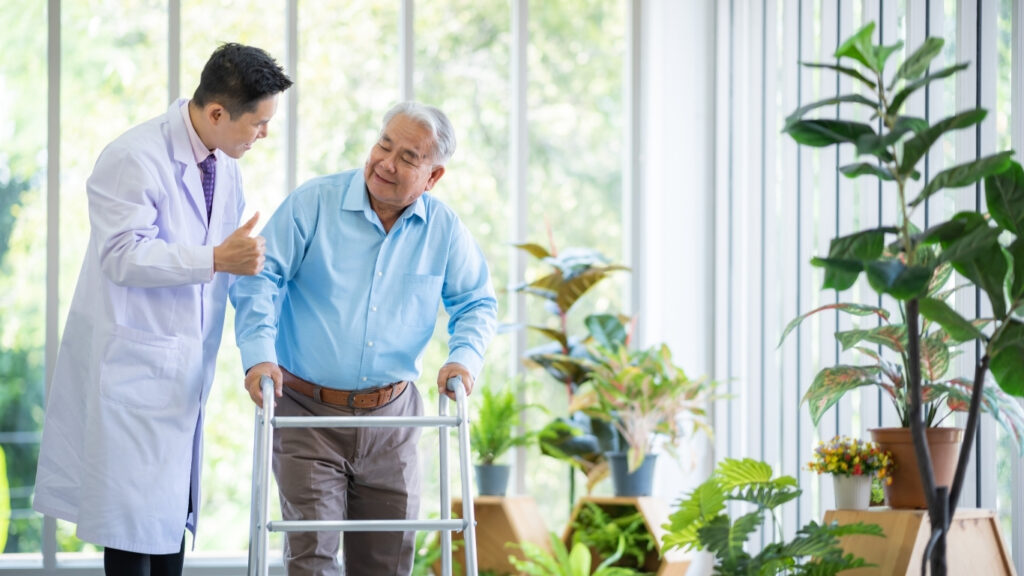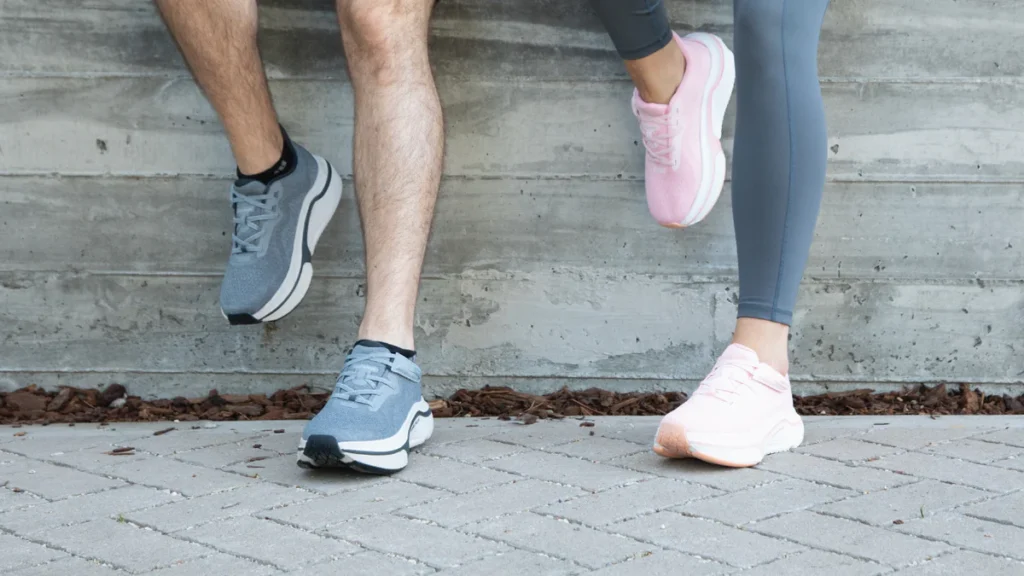10 Best Adaptive Shoes – Best Footwear for Seniors and Mobility Issues
Most of us choose our shoes based on our style and preferences, but things are different for seniors and those suffering from conditions or diseases that affect their mobility.
Common Foot Issues and Mobility Challenges
Seniors frequently face a variety of foot health problems. Conditions such as flat feet, Morton’s neuroma, and arthritis demand footwear with substantial arch support and cushioning. Swelling due to edema or diabetes requires shoes with spacious toe boxes and breathable materials. Additionally, neurological conditions like Parkinson’s or MS often lead to shuffling steps, making slip-resistant rubber soles vital for stability.
Footwear goes beyond comfort; it is a matter of safety. While stability walkers or canes provide support, the right shoes are just as crucial. For instance, adaptive footwear with rocker soles can enhance walking patterns, and orthopedic options with custom orthotics can alleviate heel discomfort. Focus on finding shoes that cater to both specific foot ailments and overall mobility requirements. That’s where adaptive shoes come in.
What Are Adaptive Shoes?
Key Adaptive Shoe Features
- Easy on/off: Shoes with wide openings and closures such as Velcro, zippers, or magnetic fasteners are ideal for those with limited hand mobility, making them simple to put on and remove.
- Adjustable fit: Features like adjustable straps and removable insoles allow for a customized fit, accommodating swelling or orthotic inserts.
- Enhanced stability: Slip-resistant soles and lightweight, flexible construction promote balance, minimize the risk of tripping, and support a smoother stride.
- Support for specific conditions: Many adaptive designs are suitable for AFO braces, foot drop, or neuropathy, offering a spacious toe box and structured support.
- Comfort and pain relief: These shoes can ease discomfort from bunions, plantar fasciitis, or nerve pain, and are designed to address numbness and sensitivity.
How Adaptive Shoes Support Mobility and Safety
Quality walking shoes for seniors do more than provide cushioning; they actively support safer movement. Rocker soles, for example, make walking less strenuous on knees and hips by easing the toe-off phase. Shoes with a broad base increase stability, and deep-tread rubber outsoles grip uneven surfaces. Lightweight designs are particularly helpful for those using stability walkers, reducing fatigue over time.
Physical therapists often recommend adaptive footwear for individuals recovering from surgery or strokes, as these shoes incorporate features like adjustable insoles and flexible midsoles to accommodate irregular gait patterns. Combined with regular walking routines, these shoes allow seniors to regain strength while reducing the risk of falls.
Remember: Foot health impacts overall wellness. Poorly fitting shoes can exacerbate knee pain, disrupt balance, and restrict mobility. On the other hand, supportive footwear, such as walking shoes for elderly women or adaptive sneakers for men, encourages activity, which is key to maintaining muscle strength and cardiovascular health.
Quick Checklist for Choosing Adaptive Shoes
- Non-slip rubber soles: Crucial for preventing falls, particularly on slippery surfaces.
- Wide-toe box shoes: Help accommodate swelling, bunions, or hammertoes without creating pressure.
- Easy closures: Hook-and-loop straps or slip-on styles simplify dressing for those with dexterity challenges.
- Lightweight, breathable materials: Options like mesh or leather prevent overheating and promote airflow.
- Cushioning: Inserts made from memory foam or gel absorb shock and reduce joint pain during extended use.
Proper fit is essential. Many seniors benefit from extra-wide shoes or styles designed for edema. Measure both feet, as swelling can cause size differences throughout the day. For residents in senior living communities, shoes with padded collars and seamless interiors prevent blisters, while pairing diabetic socks with suitable footwear can help improve circulation.
Try on shoes later in the day, when your feet are likely to be more swollen. Test them on different surfaces, carpet, tile, and pavement, to evaluate grip and comfort. If you experience significant foot pain or have plantar fasciitis, consult a podiatrist about custom orthotics. Don’t hesitate to replace shoes that have lost their support; even the best models wear out over time. Whether you need casual sneakers, dress shoes, or specialized footwear for neuropathy, always prioritize safety and adaptability. The right shoes are not a luxury, they are fundamental for maintaining independence and confidence with every step.
Top 10 Adaptive Shoes: Best Picks for Comfort, Safety, and Support
Finding the right pair of walking shoes for seniors means balancing medical needs with everyday practicality. We have tested dozens of options to bring you this curated list, prioritizing safety features like slip-resistant rubber soles, adaptive designs for specific foot conditions, and styles that suit active lifestyles.
1. Cadense Adaptive Shoes
Specially designed for seniors with MS, Parkinson’s, or foot drop, Cadense tops our list thanks to its patented adaptive technology. Each shoe features two raised nylon pucks on the sole to help glide over uneven terrain, while recessed rubber areas engage during toe-off for secure stopping. The articulated rocker sole decreases lifting effort by 37 percent, making these shoes an excellent choice for those with balance concerns or muscle weakness.
Key Features: Adaptive nylon pucks, variable friction zones, removable insoles
Best For: Minimizing slip-and-fall risks, neuropathy, and post-stroke recovery
Closure: Slip-on with elastic laces
Why choose Cadense? Unlike typical walking shoes for elderly women or men’s adaptive sneakers, these shoes actively adjust to changes in gait, making them ideal for assisted living residents who navigate various floor types.
Cadense.com | Starting at $149
2. Orthofeet Orthopedic Shoes
Orthofeet is a frequent recommendation from podiatrists for seniors suffering from heel pain or Morton’s neuroma. The stretchable upper accommodates swelling, and the wide toe box alleviates bunion pressure. Its memory foam insole can be paired with custom orthotics for severe arthritis.
Key Features: Orthopedic arch support, non-binding fit, air cushioning
Best For: Diabetic patients, those on their feet all day, chronic foot pain
Closure: Hook-and-loop straps with adjustable depth
Orthofeet.com | Starting at $139
3. Kizik Slip-On Sneakers
For those who find laces difficult, Kizik’s hands-free design allows you to step right into the sneakers. The collapsible heel springs back into place, and the lightweight mesh keeps feet cool. The reinforced toe cap ensures durability for active seniors.
Key Features: Hands-free entry, rubber outsoles, anatomical footbed
Best For: Arthritis sufferers, quick errands, comfortable walking
Closure: Elasticated tongue with no-tie laces
Kizik.com | Starting at $99
4. Friendly Shoes
Friendly Shoes are crafted for severe edema, featuring a unique wraparound zipper that expands up to 4 inches. The extra-wide fit accommodates diabetic socks without compression, and the rocker sole encourages a natural stride.
Key Features: Expandable uppers, seamless interior, antimicrobial lining
Best For: Post-surgery recovery, lymphedema, senior living communities
Closure: Adaptive zipper with pull tab
Friendlyshoes.com | Starting at $129
5. Apex Footwear
Apex offers widths up to 13E, making them ideal for seniors who need edema shoes or have flat feet. Removable insoles provide room for swelling, while the rubber sole offers dependable traction on slippery surfaces.
Key Features: Extra-depth design, stretchable leather, padded collar
Best For: Managing swelling, wide feet, all-day comfort
Closure: Dual adjustable hook-and-loop straps
Apexfoot.com | Starting at $89
6. Anodyne Shoes
Anodyne shoes have a seamless interior to eliminate friction for sensitive feet. These orthopedic shoes comply with Medicare guidelines for diabetic footwear, featuring a protective toe box and moisture-wicking lining for diabetic socks.
Key Features: Non-irritating seams, thermoformable inserts, rigid heel counter
Best For: Neuropathy, post-wound healing, shoes for elderly women
Closure: Front-mounted velcro straps
Anodyneshoes.com | Starting at $109
7. Propet Stability Slip-on Sneakers
These stability shoes are have sleek and modern slip-on designs bound to please both men and women. Available in four widths, it has a wide forefoot and heel base and slip-resistant outsoles. The Scotchguard™ protective treatment helps prevent stains and moisture.
Key Features: Slip-resistant, water repellent, removable footbed
Best For: Diabetic neuropathy, plantar fasciitis, bunions, hammertoes, and swelling
Closure: Leather/nubuck upper with elasticized collar and heel
PropetFootwear.com | Starting at $125
8. Medline Post-Op Footwear
Athome.medline.com | Starting at $39
Medline provides affordable men’s and women’s post-operative boots and shoes. They have solutions for most needs and conditions, and designs focusing on comfort, foot support, stability, and easy fixation.
Key Features: Machine-washable, reinforced heel, open toes, breathable fabric
Best For: Budget-conscious buyers, light housework, all-day standing
Closure: velcro, eyelet hooks
Athome.medline.com | Starting at $10
9. Vionic Shoes
Vionic shoes combine deep heel cup stability with arch support, cushioning, and flexibility. They improve comfort and stability and relieve pain in plantar fasciitis. Designs cover everythin from loafers and sneakers to sandals, slippers, boots and Mary Janes.
Key Features: wide footbet, cushioned insole, arch support, lightweight builds
Best For: casual walkers, seniors, office, etc.
Closure: Elastic goring panels, velcro, laces, etc.
Vionicshoes.com | Starting at $65
10. Plae Orthotic-Ready Shoes
These are shoes for men, women, and children with stretchy and breathable uppers, high ankle support, and wide tongue opening, perfect for orthotics and everyday wear.
Key Features: Patented closure system, customizable lace length, interchangeable bolts
Best For: Wide-toe needs, recovery, everyday wear
Closure: Straps, velcro, adjustable laces
Plae.com | Starting at $46
Cadense Adaptive Shoes: The Premier Choice for Walking and Mobility Support
When it comes to walking shoes that address complex mobility challenges, Cadense adaptive shoes truly shine. Engineered specifically for individuals dealing with conditions such as Parkinson’s, foot drop, and multiple sclerosis, these highly rated sneakers blend innovative technology with everyday usability. Let’s take a closer look at why more physical therapists and podiatrists are recommending Cadense as the benchmark for improving mobility and minimizing slip risks.
How the Cadense Adaptive Sole Functions
Unlike standard sneakers, Cadense features a unique sole design with two raised nylon pucks on each side. These adaptive elements sit above the main sole, forming low-friction zones that enable wearers to glide effortlessly over uneven sidewalks or doorway thresholds. Here’s the key innovation: when pressure shifts to the front of the foot, such as during toe-off, the pucks retract into a layer of ultra-soft foam. At this moment, the recessed rubber sole comes into play, delivering immediate traction for safe stops. This dynamic system more closely replicates natural walking patterns compared to the stiff rubber outsoles of typical footwear.
- Variable Friction Technology: The rocker-shaped sole alternates between the low-friction nylon pucks and higher-friction rubber, adjusting to the demands of every step.
- Pressure-Sensitive Adaptation: The nylon pucks compress under body weight, allowing for smooth, trip-free transitions.
- Exceptionally Lightweight Cushioning: The low-density foam absorbs impact, reducing joint discomfort during extended periods of standing or walking.
Advantages for Foot Drop, Parkinson’s Disease, and More
For older adults with specific foot conditions, Cadense offers tailored solutions. Those with foot drop often have difficulty lifting their toes, but the adaptive sole’s gliding effect helps decrease the risk of tripping. People with Parkinson’s or multiple sclerosis benefit from the reduced effort needed to lift their feet, a common issue that leads to shuffling. Even most shoes designed for neuropathy don’t address balance as thoroughly as Cadense does.
Take Jane, an 82-year-old with MS, for example: “Before Cadense, I needed a stability walker for short walks. Now, I can navigate my assisted living facility’s carpeted halls without catching my toes.” Testimonials like this demonstrate how Cadense Adaptive Shoes can restore confidence in daily movement.
Key Features to Help Prevent Falls
Falls are a significant concern for seniors, but Cadense tackles this with thoughtful design:
- Slip-Resistant Traction: The rubber midsole activates during toe-off to prevent slipping, even on wet floors.
- Enhanced Stability: A wider base than most senior walking shoes supports better lateral balance.
- Effortless Movement: The rocker sole reduces the energy needed for heel-to-toe transitions by 37%, as shown in lab tests, easing the strain on weakened muscles.
Unlike orthopedic shoes that often focus solely on support, Cadense combines adaptability with comfort. The memory foam insole conforms to swollen feet, and the roomy toe box relieves pressure on bunions. For residents of senior living communities, the easy slip-on design means no more struggling with laces, a real benefit for those with arthritis.
Why is this important? A 2024 study revealed that seniors using adaptive shoes experienced 52% fewer falls compared to those in regular footwear. Cadense’s specialized focus on balance and individual foot needs makes it a leading solution for preventing hospital visits.
Cadense vs. Traditional Sneakers: A Side-by-Side Look
While there are many comfortable walking shoes available, few rival the problem-solving design of Cadense. Standard sneakers with flat rubber soles create more friction, requiring users to lift their feet higher, a tiring task for those with muscle weakness. Cadense’s gliding pucks eliminate this problem, making each step feel easier and more natural. Many shoes for elderly women prioritize appearance over function, but Cadense delivers both. The breathable mesh upper keeps feet cool, while the discreet adaptive technology ensures a modern, non-medical look.
Who Should Choose Cadense Adaptive Shoes?
- Seniors recovering from strokes or surgeries who need shoes suitable for physical therapy
- Individuals with balance issues resulting from neuropathy or vertigo
- Those who use custom orthotics and require removable insoles
- Caregivers seeking reliable, slip-resistant footwear for loved ones in assisted living
Even active seniors notice a difference. “I wear them for morning walks,” says Tom, 76, who manages knee pain. “The rockered sole lets me walk farther without joint stiffness.”
The Bottom Line: Why Cadense Sets the Standard
In a market crowded with wide and extra-wide options, Cadense distinguishes itself by addressing the underlying causes of mobility difficulties. Its patented sole technology tackles the biomechanics of movement, something generic comfort shoes often overlook. For those tired of choosing between safety and style, these top-rated sneakers provide a new sense of independence.
Ready to experience the difference? Cadense offers a 30-day trial so users can test the shoes in real-life situations, from grocery store aisles to grassy parks. Pair them with diabetic socks for optimal circulation, and you have a complete system designed to support every step.







